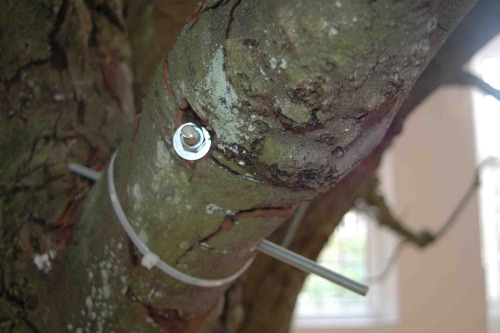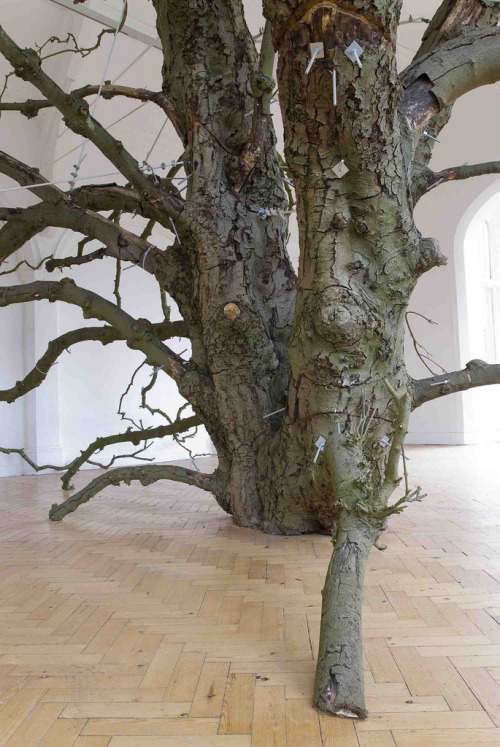Anya Gallaccio, that open space within, 2008, dead horse-chestnut tree, rope, and findings. (Photographs from Camden Arts Centre Flickr)
Anya Gallaccio often works with and transforms organic materials, and in her new exhibition at London’s Camden Arts Centre, titled “that open space within,” the artist presents the reconstructed fragments of a large chestnut tree.
"The tree had been dead a long time and was going to become unstable and dangerous. This was both good and bad for me. It reduced the weight of the wood, but it also meant that it was incredibly brittle—there was no flexibility in it. I enjoy that improvisation, the on-the-spot, pragmatic decision-making.
Some of the resulting pieces are fragile; others are hideously heavy and overbearing; the first section weighs one and a half tons. I’m amazed at the strength and engineering of trees, with their huge branches that spread out horizontally and resist the forces of the weather. Obviously, I destroyed the structural integrity of the branches by choosing to cut them, and in putting them back together chose to emphasize the mending or fixing. The bolts extend way beyond the surface of the wood—like pins in a fractured limb—and the ropes hold it in traction within the space. There’s no illusion there, and I’m not trying to disguise the artifice of the reconstruction.
I’m interested in basic, rather banal stuff, like how big trees are and how we relate to them physically. I’m a real townie; I’m a little bit terrified and overwhelmed by nature. My curiosity is more morbid than celebratory.”
Except from Artforum.
Anya Gallaccio often works with and transforms organic materials, and in her new exhibition at London’s Camden Arts Centre, titled “that open space within,” the artist presents the reconstructed fragments of a large chestnut tree.
"The tree had been dead a long time and was going to become unstable and dangerous. This was both good and bad for me. It reduced the weight of the wood, but it also meant that it was incredibly brittle—there was no flexibility in it. I enjoy that improvisation, the on-the-spot, pragmatic decision-making.
Some of the resulting pieces are fragile; others are hideously heavy and overbearing; the first section weighs one and a half tons. I’m amazed at the strength and engineering of trees, with their huge branches that spread out horizontally and resist the forces of the weather. Obviously, I destroyed the structural integrity of the branches by choosing to cut them, and in putting them back together chose to emphasize the mending or fixing. The bolts extend way beyond the surface of the wood—like pins in a fractured limb—and the ropes hold it in traction within the space. There’s no illusion there, and I’m not trying to disguise the artifice of the reconstruction.
I’m interested in basic, rather banal stuff, like how big trees are and how we relate to them physically. I’m a real townie; I’m a little bit terrified and overwhelmed by nature. My curiosity is more morbid than celebratory.”
Except from Artforum.



